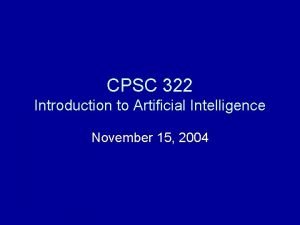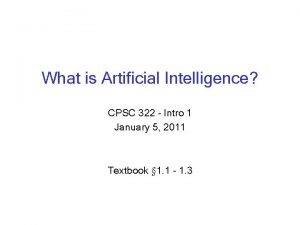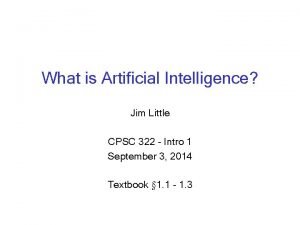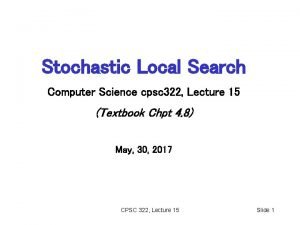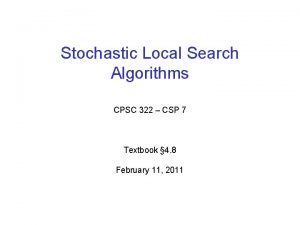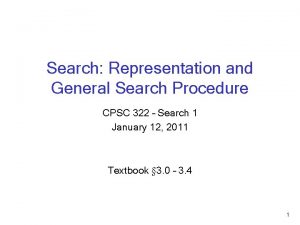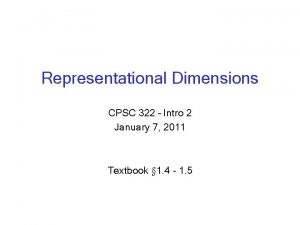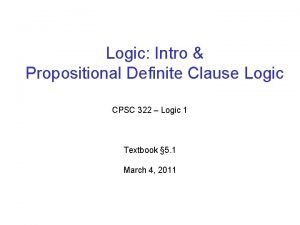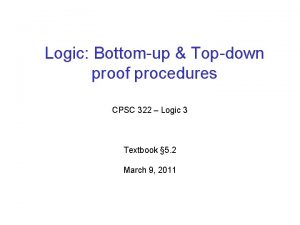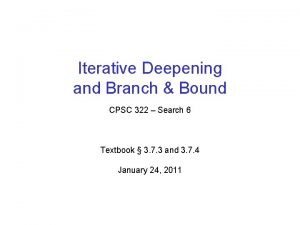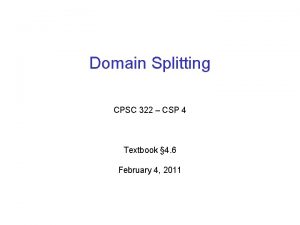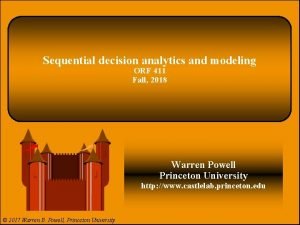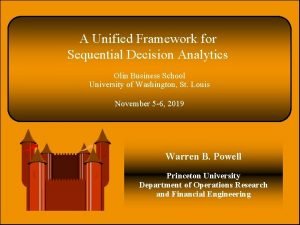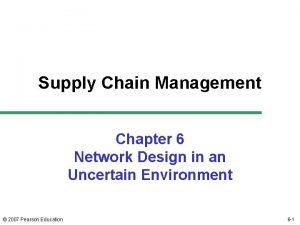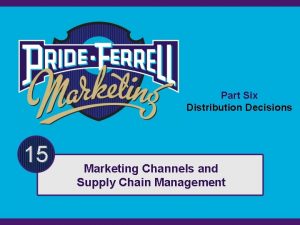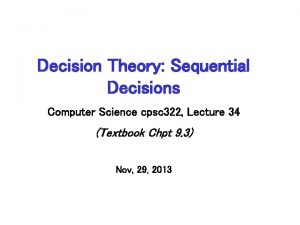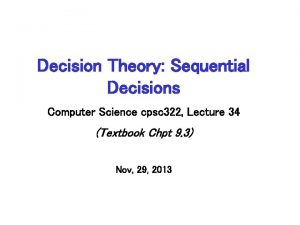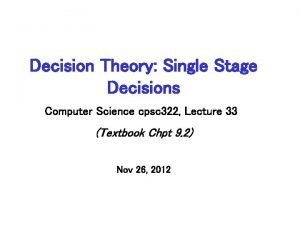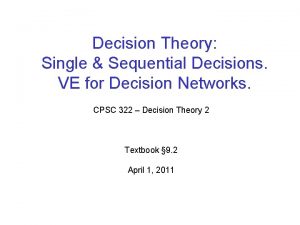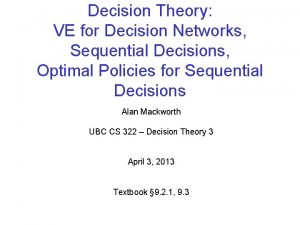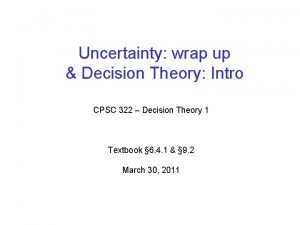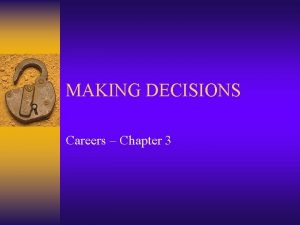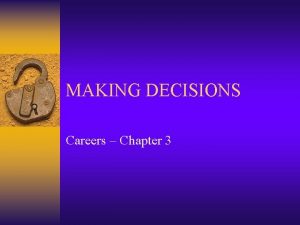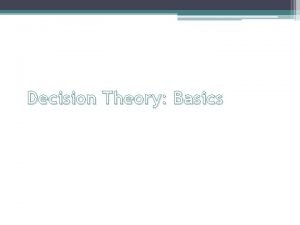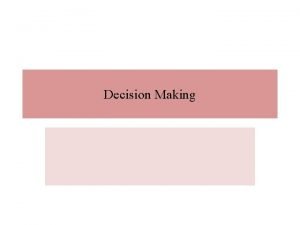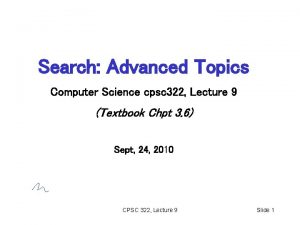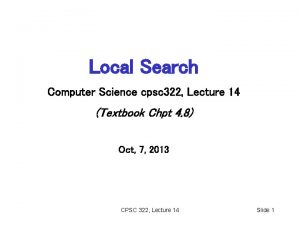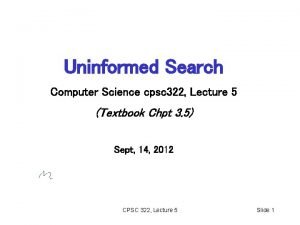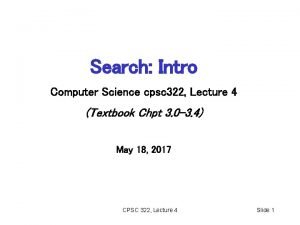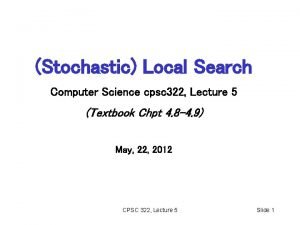Decision Theory Sequential Decisions Computer Science cpsc 322





















- Slides: 21

Decision Theory: Sequential Decisions Computer Science cpsc 322, Lecture 34 (Textbook Chpt 9. 3) April, 1, 2009

Lecture Overview • Recap (Example One-off decision, single stage decision network) • Sequential Decisions • Finding Optimal Policies

“Single” Action vs. Sequence of Actions Set of primitive decisions that can be treated as a single macro decision to be made before acting • Agent makes observations • Decides on an action • Carries out the action

Recap: One-off decision example Delivery Robot Example • Robot needs to reach a certain room • Going through stairs may cause an accident. • It can go the short way through long stairs, or the long way through short stairs (that reduces the chance of an accident but takes more time) • The Robot can choose to wear pads to protect itself or not (to protect itself in case of an accident) but pads slow it down • If there is an accident the Robot does not get to the room

Lecture Overview • Recap (Example One-off decision, single stage decision network) • Sequential Decisions • Representation • Policies • Finding Optimal Policies

Sequential decision problems • A sequential decision problem consists of a sequence of decision variables D 1 , …. . , Dn. • Each Di has an information set of variables p. Di, whose value will be known at the time decision Di is made.

Sequential decisions : Simplest possible • Only one decision! (but different from one-off decisions) • Early in the morning. Shall I take my umbrella today? (I’ll have to go for a long walk at noon) • Relevant Random Variables?

Policies for Sequential Decision Problem: Intro • A policy specifies what an agent should do under each circumstance (for each decision, consider the parents of the decision node) In the Umbrella “degenerate” case: D 1 p. D 1 How many policies? One possible Policy

Sequential decision problems: “complete” Example • A sequential decision problem consists of a sequence of decision variables D 1 , …. . , Dn. • Each Di has an information set of variables p. Di, whose value will be known at the time decision Di is made. No-forgetting decision network: • decisions are totally ordered • if a decision Db comes before Da , then • Db is a parent of Da • any parent of D is a parent of D

Policies for Sequential Decision Problems • A policy is a sequence of δ 1 , …. . , δn decision functions δi : dom(p. Di ) → dom(Di ) • This policy means that when the agent has observed O dom(p. Di ) , it will do δi(O) Example: Report How many policies? true false Check. Smoke true false Check Smoke See. Smoke true false Call true false false

Lecture Overview • Recap • Sequential Decisions • Finding Optimal Policies

When does a possible world satisfy a policy? • A possible world specifies a value for each random variable and each decision variable. • Possible world w satisfies policy δ , written w ╞ δ if the value of each decision variable is the value selected by its decision function in the policy (when applied in w). Decision function for… VARs Fire Tampering Alarm Leaving Report Smoke See. Smoke Check. Smoke Call true false true true Report Check Smoke true false Decision function for… Report true false Check. Smoke true false See. Smoke Call true false true false false

When does a possible world satisfy a policy? • Possible world w satisfies policy δ , written w ╞ δ if the value of each decision variable is the value selected by its decision function in the policy (when applied in w). Decision function for… VARs Fire Tampering Alarm Leaving Report Smoke See. Smoke Check. Smoke Call true false true true Report Check Smoke true false Decision function for… Report true false Check. Smoke true false See. Smoke Call true false true false false

Expected Value of a Policy • Each possible world w has a probability P(w) and a utility U(w) • The expected utility of policy δ is • The optimal policy is one with the expected utility.

Lecture Overview • Recap • Sequential Decisions • Finding Optimal Policies (Efficiently)

Complexity of finding the optimal policy: how many policies? • How many assignments to parents? • How many decision functions? (binary decisions) • How many policies? • If a decision D has k binary parents, how many assignments of values to the parents are there? • If there are b possible actions, how many different decision functions are there? • If there are d decisions, each with k binary parents and b possible actions, how many policies are there?

Finding the optimal policy more efficiently: VE 1. Remove all variables that are not ancestors of the utility node 2. Create a factor for each conditional probability table and a factor for the utility. 3. Sum out random variables that are not parents of a decision node. 4. Eliminate (aka sum out) the decision variables 5. Sum out the remaining random variables. 6. Multiply the factors: this is the expected utility of the optimal policy.

Eliminate the decision Variables: details • Select a variable D that corresponds to the latest decision to be made • this variable will appear in only one factor with its parents • Eliminate D by maximizing. This returns: • The optimal decision function for D, arg max. D f • A new factor to use in VE, max. D f • Repeat till there are no more decision nodes. Example: Eliminate Check. Smoke Report true false Check. Smoke true false Value -5. 0 -5. 6 -23. 7 -17. 5 Report Value New factor true false Decision Function Report true false Check. Smoke

VE elimination reduces complexity of finding the optimal policy • We have seen that, if a decision D has k binary parents, there are b possible actions, If there are d decisions, k d 2 • Then there are: (b ) policies • Doing variable elimination lets us find the optimal policy after k 2 considering only d. b policies (we eliminate one decision at a time) • VE is much more efficient than searching through policy space. • However, this complexity is still doubly-exponential we'll only be able to handle relatively small problems.

Learning Goals for today’s class You can: • Represent sequential decision problems as decision networks. And explain the non forgetting property • Verify whether a possible world satisfies a policy and define the expected value of a policy • Compute the number of policies for a decision problem • Compute the optimal policy by Variable Elimination CPSC 322, Lecture 4 Slide 20

Next class • Value of Information and control – textbook sect 9. 4 (needed for last question Assign. #4) • More examples of decision networks Return Assign 3 • Need to talk to student 521320
 Decisions decisions decisions poster
Decisions decisions decisions poster Cpsc 322
Cpsc 322 Cpsc 322: introduction to artificial intelligence
Cpsc 322: introduction to artificial intelligence Cpsc 322: introduction to artificial intelligence
Cpsc 322: introduction to artificial intelligence Ubc cpsc 322
Ubc cpsc 322 Cpsc 322
Cpsc 322 Cpsc 322
Cpsc 322 Cpsc 322
Cpsc 322 Cpsc 322
Cpsc 322 Definite clause logic
Definite clause logic Cpsc 322
Cpsc 322 Iterative deepening search example
Iterative deepening search example Cpsc 322
Cpsc 322 Objectives of decision making
Objectives of decision making Slidetodoc.com
Slidetodoc.com Screening decisions and preference decisions
Screening decisions and preference decisions Sequential decision analytics
Sequential decision analytics Sequential decision analytics
Sequential decision analytics Supply chain network design decisions
Supply chain network design decisions Distribution decisions in marketing
Distribution decisions in marketing Multiple distribution channel
Multiple distribution channel That's my favorite
That's my favorite

